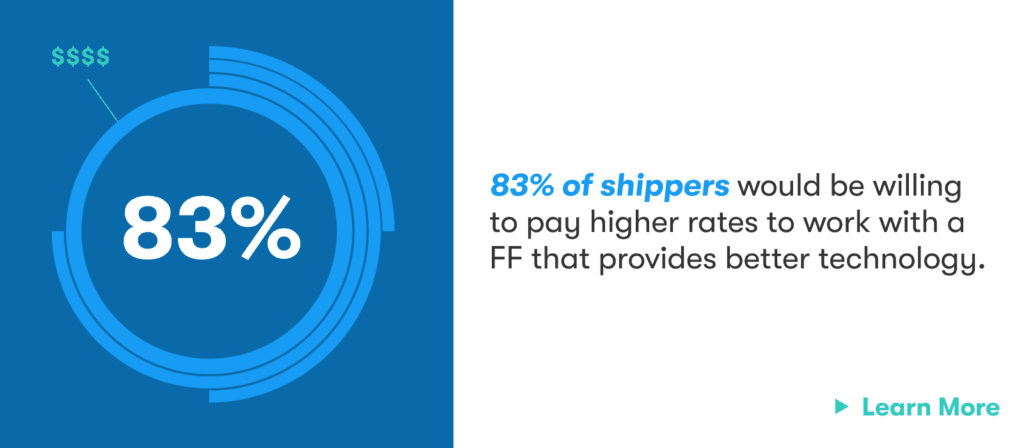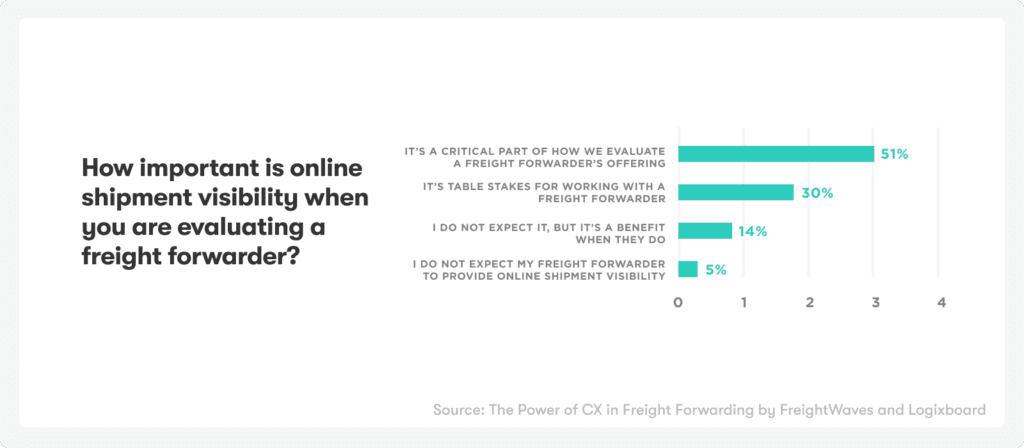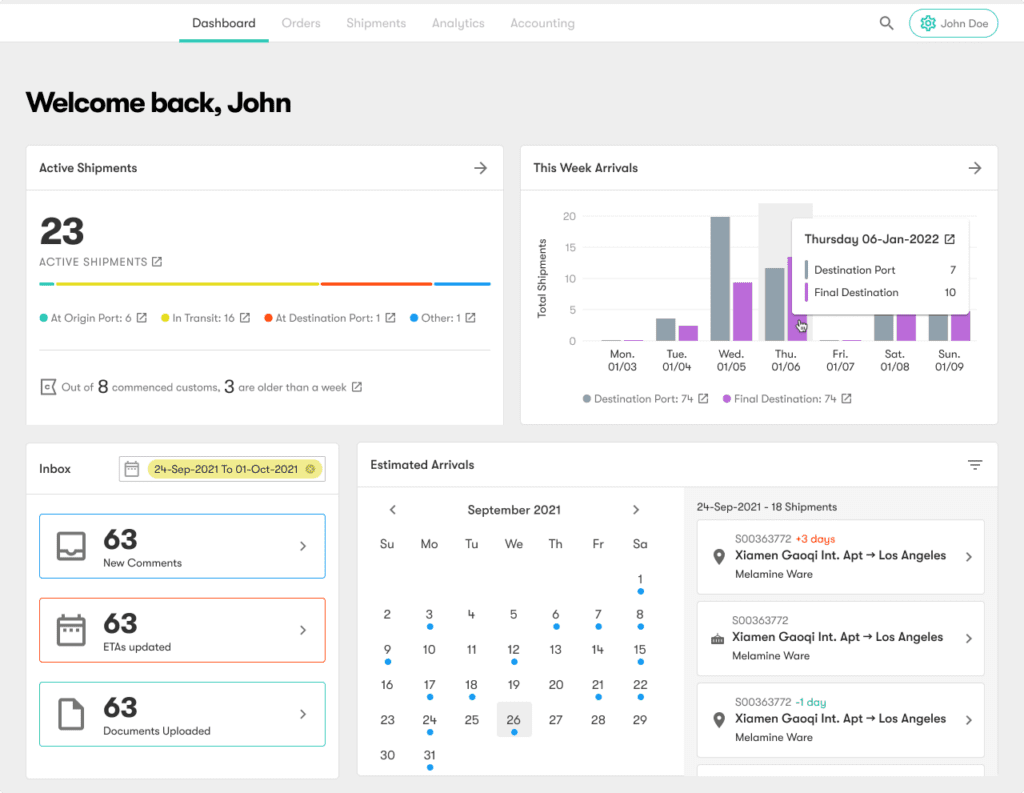In today’s fast-paced business environment, customers expect timely and accurate delivery of goods. As businesses strive to meet customers’ evolving expectations, many are looking into implementing real-time visibility solutions to keep their shippers in the loop.
However, as the need for alignment expands across the industry, the term “real-time shipment visibility” has become something of a buzzword. Let’s get back to the basics to talk about what shipment visibility really looks like, and how forwarders can leverage it to improve their operations and grow their business.
What is real-time shipment visibility?
“Real-time” shipment visibility refers to the process of getting up-to-date information on your cargo at every step along its journey, from leaving the warehouse to reaching its final destination. This level of visibility allows businesses to monitor their shipments continuously, receive alerts in case of delays or issues, and make real-time decisions to optimize their supply chain operations.
Vessel vs. container-level tracking
Not all real-time visibility data is created equal. In ocean freight, for instance, there are two main levels: vessel and container tracking.
With vessel-level tracking, shippers and forwarders can locate their cargo’s ship at any point in time from an automatic identification system (AIS). Based on transceiver or satellite data, this will tell you your vessel’s position, course, and speed to calculate an accurate ETA.
With container-level tracking, by contrast, you’ll get visibility into the status of your exact container. The source of this data can vary depending on the carrier, location, or a variety of other factors. It typically comes from getting scanned at the port and uploaded to a tracking system. However, in some cases, this information may also be collected manually by port workers jotting down container ID numbers as they come in.
Due to its level of granularity, container-level visibility provides shippers with more actionable information. However, it’s also much costlier, as many providers need to pay for data on a per-container basis. It can also be slightly less “real-time,” as you may expect to wait for more manual updates to be made depending on the various setups at each stage of the journey.
What real-time shipment visibility is not
While the phrase “real-time visibility” may sound pretty straightforward, it can be a little bit misleading. The way it’s often described, it sounds like you’re watching a continuous feed of your shipment moving across the ocean until it reaches its destination.
In reality, most “real-time” data comes from pings from when your container is scanned at each checkpoint. Therefore, you’ll get updates based on the milestones your container has reached, like “picked up from warehouse,” “arrived at port,” or “cleared customs.”
While some logistics providers talk about getting location data through GPS and IoT sensors, sticking a tracking device on every container typically isn’t the most cost-effective solution. Therefore, it’s a lot less common than many forwarders would think. And in the end, that’s not such a bad thing. Although getting the ability to track your container inch-by-inch might give you peace of mind, it only offers a marginal benefit in practice.
After all, as a shipper, what would you prefer to get visibility into: When your container is making its way across ocean? Or when it’s stuck at customs? By getting insights into your shipment’s key milestones, you’ll be alerted when you actually need to take action.
Why forwarders are investing in offering real-time shipment visibility to customers
Even when considering the initial investment required to implement a visibility solution, the return on investment is well worth the cost. In fact, according to a survey by FreightWaves and Logixboard, 83% of shippers would pay higher rates to work with a freight forwarder that offers better tech, visibility, and control over their supply chain.

Reduces unexpected costs and disruptions
Real-time shipment visibility enables businesses to identify potential issues and address them before they become major problems. By having real-time visibility into the movement of goods, businesses can take action to avoid unexpected costs, such as detention and demurrage charges. They can also more quickly resolve paperwork issues or rearrange plans to prevent their shipment from being delayed.
Improves customer experience
With a real-time visibility solution, you can give your customers an up-to-date view of their shipment status. Compared to manual processes like requesting periodic updates through phone calls and emails, this can reduce friction and improve information accuracy throughout the shipment journey. In turn, your customers will spend less time worrying about minor details and issues– leading to a better experience overall.
With the rise in real-time visibility technology, many shippers have also come to expect this feature from their forwarders. In the previously mentioned survey, 81% of shippers cited online shipment visibility as “table stakes” or “a critical part” in evaluating a forwarder’s offering. As logistics tech continues to expand, failure to provide visibility into your shipments can make it difficult to compete in the marketplace. Additionally, by getting access to self-serve resources, shippers can get a better sense of control over their cargo.

Promotes partnership with shippers
In addition to improving customer experience, implementing a visibility solution can also strengthen your business relationship. For one, giving them a view of the shipments you’re facilitating can build trust, as your customer can be certain that they’re getting prompt updates about their cargo status.
Customer experience platforms like Logixboard can also provide you and your shipper with the same dashboard view. This can enable quicker communication between parties, as you’ll both have access to the same information and updates in real-time. You’ll also be able to more easily collaborate to resolve issues or disruptions that arise.

Offering real-time visibility can also help your customers grow in the long-term. By providing shippers with real-time data on their shipments, forwarders can work hand-in-hand with their customers to develop business strategies that align with their unique goals. By leveraging this rich data set, forwarders can identify patterns and pain points and offer tailored advice to optimize processes and minimize delays.
For example, suppose your shippers are experiencing consistent customs-related holdups due to incomplete paperwork. In that case, real-time visibility can help you develop solutions to refine their processes and prevent delays, ultimately boosting their bottom line.
As your customers see that you’re invested in their growth, they’ll be more likely to treat you as a strategic partner. In many cases, this can improve retention and even lead them to expand their account.
Leveraging real-time shipment tracking data for your operations
Although real-time shipment visibility can be a valuable feature for shippers, it also presents a wealth of untapped potential for forwarders. Leveraging this technology can have far-reaching implications, from improving predictive analytics to optimizing supply chain operations.
In harnessing the power of tracking data, forwarders can gain deeper insights into their own planning and make data-driven decisions that maximize efficiency and reduce costs. By capturing granular data, such as the length of each leg of the shipment, forwarders can pinpoint trends and patterns and take a more proactive approach to their supply chain operations.
Over time, you can use this model to optimize routes and refine your ETAs, providing your customers with unmatched accuracy. This strategic advantage can help forwarders optimize their business processes and ultimately gain a competitive edge in a crowded market.
Real-time shipment visibility in action
Diving into real-time visibility isn’t just an appealing idea for the future of logistics. Real companies are already using it to win business and increase revenue, including many of our customers at Logixboard.
Upgrading to a visibility dashboard to retain business
Since 1992, Indiana-based Cargo Services Inc. (CSI) has served shippers with a “3C Philosophy: customer focused, creative solutions, and community driven.” However, as a Descartes OneView customer, CSI faced significant challenges in delivering the level of visibility that they aspired to offer to their own customers directly via their transportation management system (TMS).
To overcome this obstacle, they decided to create their own manual process to provide customer-facing visibility using Google Sheets. However, as this method brought time-consuming workflows and increased the odds of data entry errors, customers began to increase the pressure.
One of their major accounts opted to split their orders with a different forwarder in order to explore superior digital customer experience options. At the same time, another customer engaged in discussions regarding a competitor’s tracking map feature.
That’s when CSI decided to partner with Logixboard to offer their customers a dedicated customer experience platform. After a seamless integration, CSI was able to win back the other half of the business that one of their largest customers that had decided to test with a competitor. The platform’s live tracking and visibility features also delighted the other customer who was seeking greater visibility.
After further conversations with customers, CSI learned that their exceptional service and industry expertise had already set them apart from their competitors.
“Your system is just as good at the leading digital-first forwarders, and you guys are much better at moving freight than they are.”
From a CSI Customer ?
However, by enhancing their digital customer experience offerings, they made a giant leap forward in their business evolution. This move has not only secured customer loyalty but also strengthened the foundation of trust that they have worked hard to establish.
Read the full story: Cargo Services Inc. Wins Back & Retains Business by Pairing Customer Service with the Logixboard Platform
Competing with digital forwarders to win over $2.3 million in revenue
Air & Sea International is a transportation company driven by a culture of service since its founding in 1985. Early in 2020, president Jason Fowler brainstormed how to leverage their service culture to hit the company’s growth plans, aiming to answer two main questions:
- How can we continue to improve and evolve the customer service to stay ahead of competition?
- How can we get our foot in the door with more prospects to prove our customer focused approach and win long term customers?
As he thought about how to solve challenge #1, Jason noticed that customer expectations were shifting. While shippers still valued Air & Sea’s traditional hands-on approach to customer service, they now needed a quicker, easier, and more scalable way to get updates. This led Jason to seek out an online platform where they could access and share real-time information about their cargo.
Air & Sea’s sense of urgency grew when they responded to an RFP that put them in direct competition with major players, including Kuehne + Nagel, Maersk, Expeditors, and more. By adopting Logixboard to ramp up their customer experience, they ended up winning the RFP for an $800,000 account.
Moving forward, they continued to use their platform to increase sales, using Logixboard as a way to differentiate themselves and position Air & Sea as a modern and innovative service provider.
“Within four months of bringing on Logixboard as our digital customer experience platform, my team and I were able to close 6 new customers worth $1.5M in revenue. And for 3 of those deals, we were competing directly against Flexport.”
– Jason Fowler, President of Air & Sea International
Read the full story: Competing Against Giants: How Air and Sea beat Kuehne + Nagel, Expeditors and Flexport to win over $2.3M in revenue… in 4 Months
Final thoughts
Real-time shipment visibility is an essential component of modern supply chain management. It enables businesses to monitor their shipments continuously, receive alerts in case of issues, and make real-time decisions to optimize their operations. By implementing a real-time shipment visibility solution, businesses can improve their day-to-day efficiency for both customers and their own operations.
Give your customers unmatched visibility into their shipments. Connect with our team to check out Logixboard’s white-labeled customer experience platform.
READ MORE FROM THE LOGIXBOARD BLOG
 Matt Fleming
Matt Fleming 



